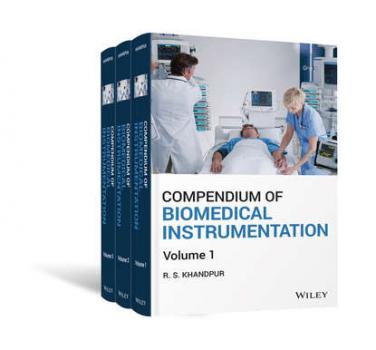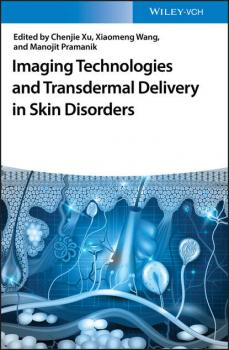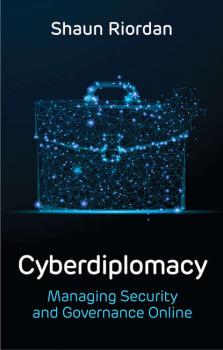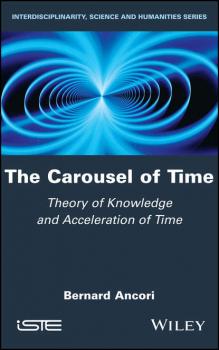MREADZ.COM - много разных книг на любой вкус
Скачивание или чтение онлайн электронных книг.Compendium of Biomedical Instrumentation
The field of medical instrumentation is inter-disciplinary, having interest groups both in medical and engineering professions. The number of professionals associated directly with the medical instrumentation field is increasing rapidly due to intensive penetration of medical instruments in the health care sector. In addition, the necessity and desire to know about how instruments work is increasingly apparent. Most dictionaries/encyclopedias do not illustrate properly the details of the bio-medical instruments which can add to the knowledge base of the person on those instruments. Often, the technical terms are not covered in the dictionaries. Unless there is a seamless integration of the physiological bases and engineering principles underlying the working of a wide variety of medical instruments in a publication, the curiosity of the reader will not be satisfied. The purpose of this book is to provide an essential reference which can be used both by the engineering as well as medical communities to understand the technology and applications of a wide range of medical instruments. The book is so designed that each medical instrument/ technology will be assigned one or two pages, and approximately 450 medical instruments are referenced in this edition.
Cell Culture Engineering
Offers a comprehensive overview of cell culture engineering, providing insight into cell engineering, systems biology approaches and processing technology In Cell Culture Engineering: Recombinant Protein Production, editors Gyun Min Lee and Helene Faustrup Kildegaard assemble top class authors to present expert coverage of topics such as: cell line development for therapeutic protein production; development of a transient gene expression upstream platform; and CHO synthetic biology. They provide readers with everything they need to know about enhancing product and bioprocess attributes using genome-scale models of CHO metabolism; omics data and mammalian systems biotechnology; perfusion culture; and much more. This all-new, up-to-date reference covers all of the important aspects of cell culture engineering, including cell engineering, system biology approaches, and processing technology. It describes the challenges in cell line development and cell engineering, e. g. via gene editing tools like CRISPR/Cas9 and with the aim to engineer glycosylation patterns. Furthermore, it gives an overview about synthetic biology approaches applied to cell culture engineering and elaborates the use of CHO cells as common cell line for protein production. In addition, the book discusses the most important aspects of production processes, including cell culture media, batch, fed-batch, and perfusion processes as well as process analytical technology, quality by design, and scale down models. -Covers key elements of cell culture engineering applied to the production of recombinant proteins for therapeutic use -Focuses on mammalian and animal cells to help highlight synthetic and systems biology approaches to cell culture engineering, exemplified by the widely used CHO cell line -Part of the renowned «Advanced Biotechnology» book series Cell Culture Engineering: Recombinant Protein Production will appeal to biotechnologists, bioengineers, life scientists, chemical engineers, and PhD students in the life sciences.
Magnetic Sensors for Biomedical Applications
An important guide that reviews the basics of magnetic biosensor modeling and simulation Magnetic Sensors for Biomedical Applications offers a comprehensive review of magnetic biosensor modelling and simulation. The authors—noted experts on the topic—explore the model's strengths and weaknesses and discuss the competencies of different modelling software, including homemade and commercial (for example Multi-physics modelling software). The section on sensor materials examines promising materials whose properties have been used for sensing action and predicts future smart-materials that have the potential for sensing application. Next, the authors present classifications of sensors that are divided into different sub-types. They describe their working and highlight important applications that reveal the benefits and drawbacks of relevant designs. The book also contains information on the most recent developments in the field of each sensor type. This important book: Provides an even treatment of the major foundations of magnetic biosensors Presents problem solution methods such as analytical and numerical Explains how solution methods complement each other, and offers information on their materials, design, computer aided modelling and simulation, optimization, and device fabrication Describes modeling work challenges and solutions Written for students in electrical and electronics engineering, physics, chemistry, biomedical engineering, and biology, Magnetic Sensors for Biomedical Applications offers a guide to the principles of biomagnetic sensors, recent developments, and reveals the impact of sensor modelling and simulation on magnetic sensors.
Chemical Biology of Neurodegeneration
Bridges the gap between the chemistry of small molecule neuromodulators and the complex pattern of neurodegenerative disorders Written by an experienced neurochemist, this book focuses on the main actors involved in neurodegenerative disorders at a molecular level, and places special emphasis on structural aspects and modes of action. Drawing on recent data on enzyme structure, mode of action, and inhibitor design, it describes?from a biochemical point of view?the six most important neurotransmitter systems and their constituent enzymes and receptors. Misfolding and aggregation of proteins within the brain is also covered. In addition, the book surveys a wide range of proven and prospective therapeutic agents that modulate key processes in the brain, from their chemical synthesis to their mode of action in model systems as well as in the patient. Chemical Biology of Neurodegeneration: A Molecular Approach is presented in two parts. The first introduces the neurotransmitter systems and provides a general explanation of the synapse and a description of the main structures involved in neurotransmission that can be considered therapeutic targets for disorders of the central nervous system. The second part presents molecular and chemical aspects directly involved or affected in neurodegeneration, including the metabolism of neurotransmitters, enzymes processing neurotransmitters, protein misfolding, and therapeutic agents. -Uses an interdisciplinary approach to bridge the gap between the basic biochemical events in a nerve cell and their neurological effects on the brain -Places emphasis on the chemistry of small molecule modulators that are potential lead molecules for new drugs -Covers six key neurotransmitter systems and their enzymes and receptors?dopaminergic, noradrenergic, serotonergic, cholinergic, GABAergic, and glutamatergic Chemical Biology of Neurodegeneration: A Molecular Approach is a key resource for medicinal chemists, neurobiologists, neurochemists, biochemists, molecular biologists, and neurophysiologists.
Imaging Technologies and Transdermal Delivery in Skin Disorders
Provides the latest information on imaging technologies and transdermal delivery in skin disorders This important, timely book covers the latest understanding about today's major skin disorders, the development of imaging technologies for skin diagnosis, and the applications of micro/nano-technologies for the treatment of skin complications. It also places great emphasis on the critical role that interdisciplinary science occupies to achieve the requisite level of understanding of skin conditions and their management, which is essential to creating technologies that work. Imaging Technologies and Transdermal Delivery in Skin Disorders starts by outlining the structural characteristics of skin and skin appendages. It then discusses the key pathways involved in skin growth and development. Clinical presentations, pathophysiological mechanisms, and current clinical practices used to treat diseases affecting the skin are then introduced. Common preclinical models used for studying the mechanisms of diverse skin diseases, validation of novel therapeutic targets, and screening of new drugs to treat these diseases are also covered. The book examines the latest imaging technologies for understanding in vivo skin changes, as well as technologies such as high-resolution ultrasound imaging, quantitative Magnetic Resonance Imaging, high-resolution Optical Coherence Tomography, and emerging hybrid-imaging modalities. It concludes with chapters introducing emerging drug delivery technologies and potential future innovative developments. Presents up-to-date knowledge of the skin biology and pathologies Introduces advancements in the topic of imaging technology for tracing the drug delivery process, which is rarely systematically reported by other counterparts Covers the latest development in three inter-related directions of drug delivery, imaging, and skin disease intersect for skin research Provides an overview of the latest development of diagnostic and therapeutic technologies for skin diseases Imaging Technologies and Transdermal Delivery in Skin Disorders will be of great interest to analytical chemists, materials scientists, pharmaceutical chemists, clinical chemists, biotechnologists, bioengineers, cosmetics industry, and dermatologists.
Enzyme-Based Computing Systems
This systematic and comprehensive overview of enzyme-based biocomputing is an excellent resource for scientists and engineers working on the design, study and applications of enzyme-logic systems.
Lehrbuch der Biochemie
Mit erweiterten Lernhilfen vermittelt auch die dritte Auflage des «Voet» die unverzichtbaren Grundlagen und zentralen Themen der Biochemie. Die chemische Perspektive wird ergänzt durch wichtige Anwendungen aus Biotechnologie, Medizin und Pharmazie.
Visioning Augustine
The definitive compendium of Cavadini’s essays on Augustine Visioning Augustine offers readers an expertly selected collection of essays exploring the text and history of the theology of Saint Augustine. Prominent scholar and essayist, John Cavadini, offers modern audiences an innovative framework for understanding Augustine, integrating articles and essays on significant texts, historical and contemporary perspectives and insights into Augustine’s development as a theologian. Examining themes such as the transformation of the human will in De doctrina Christiana and Augustine’s critique of philosophy in City of God, Cavadini provides clear and accessible smaller-size essays that serve as entry points for those interested in Augustinian scholarship. The author’s meditations on Augustinian texts invite readers to re-evaluate their interpretations and learn about the subtle and sophisticated vocabulary of Augustine. An encounter with Augustine the Christian theologian, Cavadini contends, is not a narrowly focused parochial experience, but instead a challenge to enlarge our horizons. Written by one of the most prominent Augustinian scholars and essayists in the field Addresses ecumenical and cultural issues that weaken contemporary interest in Christian faith Offers modern readers historical context on Augustinian theology Provides a single-volume collection of Cavadini’s essays on Augustine written over the course of more than two decades Accessible prose and intellectual sensitivity to modern theological problemsmake Visioning Augustine an indispensable volume for graduate students, scholars and professionals in all areas of Christian theology.
Cyberdiplomacy
The world has been sleep-walking into cyber chaos. The spread of misinformation via social media and the theft of data and intellectual property, along with regular cyberattacks, threaten the fabric of modern societies. All the while, the Internet of Things increases the vulnerability of computer systems, including those controlling critical infrastructure. What can be done to tackle these problems? Does diplomacy offer ways of managing security and containing conflict online? In this provocative book, Shaun Riordan shows how traditional diplomatic skills and mindsets can be combined with new technologies to bring order and enhance international cooperation. He explains what cyberdiplomacy means for diplomats, foreign services and corporations and explores how it can be applied to issues such as internet governance, cybersecurity, cybercrime and information warfare. Cyberspace, he argues, is too important to leave to technicians. Using the vital tools offered by cyberdiplomacy, we can reduce the escalation and proliferation of cyberconflicts by proactively promoting negotiation and collaboration online.
The Carousel of Time
Based around the image of a carousel, this book uses epistemological theory to tackle the paradoxical acceleration and deceleration of time that is experienced by many. The consequence of this paradox is the observance of the past, present and future coinciding, where acceleration is combined with perfect immobility. The Carousel of Time proposes a model that focuses on a complex network of individual actors, and their relation to the analysis, structure and evolution of our socio-cognitive space–time. The first part of the book, «Foundations», presents the key bases of this model, as well as the notions that must be understood and integrated. The book then analyzes the concept of «Space», defining the parameters of the network’s boundaries, and finishes with an exploration of «Time». This third part links the temporality of the network to its spatial characteristics and studies its evolution.









